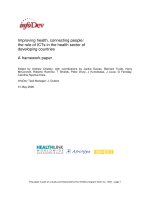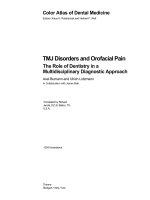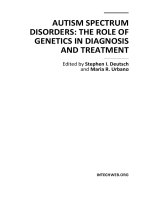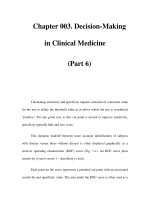THE ROLE OF SURGERY IN HEART FAILURE - part 6 doc
Bạn đang xem bản rút gọn của tài liệu. Xem và tải ngay bản đầy đủ của tài liệu tại đây (102.69 KB, 2 trang )
after cardiopulmonary bypass. Circulation 1993;88:
2128–38.
[71] Fullerton DA, McIntyre RC Jr. Inhaled nitric oxide:
therapeutic applications in cardiothoracic surgery.
Ann Thorac Surg 1996;61:1856–64.
[72] Fullerton DA, Jones SD, Jaggers J, et al. Effective
control of pulmonary vascular resistance with in-
haled nitric oxide following cardiac operation.
J Thorac Cardiovasc 1996;111:753–63.
[73] Girard C, Lehot JJ, Pannetier JC, et al. Inhaled
nitric oxide after mitral valve replacement in patients
with chronic pulmonary hypertension. Anesthesiol-
ogy 1992;77:880–3.
[74] Fullerton DA, Jaggers J, Wollmering M, et al. Vari-
able response to inhaled nitric oxide following car-
diac surgery. Ann Thorac Surg 1997;63:1251–6.
[75] Fullerton DA, McIntyre RC Jr, Hahn AR, et al.
Dysfunction of cGMP-mediated pulmonary vasore-
laxation in endotoxin induced acute lung injury. Am
J Physiol 1995;268:L1029–35.
[76] Fullerton DA, Jaggers J, Piedalue F, et al. Effective
control of refractory pulmonary hypertension after
cardiac surgery. J Thorac Cardiovasc Surg 1997;
113:365–8.
[77] Argenziano M, Choudhri AF, Moazami N, et al.
Randomised double blind trial of inhaled nitric ox-
ide in LVAD recipients with pulmonary hyperten-
sion. Ann Thorac Surg 1998;65:340–5.
[78] Kieler-Jenson N, Lundin S, Ricksten SE. Vasodila-
tor therapy after heart transplantation: effects of in-
haled nitric oxide, and intravenous prostacyclin,
prostaglandin E, and sodium nitroprusside. J Heart
Lung Transplant 1995;14:436–43.
[79] Aaronson KD, Patel H, Pagani FD. Patient selec-
tion for left ventricular assist device therapy. Ann
Thorac Surg 2003;75:S29–35.
[80] Taylor DO, Edwards LB, Bouck MM, et al. Registry
of The International Society for Heart and Lung
Transplantation: Twenty-third Official Adult Heart
Transplantation Reportd2006. J Heart Lung
Transplant 2006;25:869–79.
[81] Oz MC, Goldstein DJ, Pepino P, et al. Screening
scale predicts patients successfully receiving long
term implantable left ventricular assist devices. Cir-
culation 1995;92(Suppl II):II169–73.
[82] Entwistle JWC. Short and long term mechanical
ventricular assistance towards myocardial recovery.
Surg Clin North Am 2004;84:201–21.
[83] Samuel LE, Holmes EC, Thomas MP, et al. Man-
agement of acute cardiac failure with mechanical as-
sist: experience with the ABIOMED BVS 5000. Ann
Thorac Surg 2001;71:S67–72.
[84] Jett GK. Postcardiotomy support with ventricular
assist devices; selection of recipients. Semin Thorac
Cardiovasc Surg 1994;6:136–9.
[85] Guyton RA, Schonberger J, Everts P, et al. Post car-
diotomy shock: clinical evaluation of the BVS 5000
biventricular support system. Ann Thorac Surg
1993;56:346–56.
[86] Samuels LE, Kaufman MS, Thomas MP, et al. Phar-
macologic criteria for ventricular assist device inser-
tion: experience with the ABIOMED BVS 5000.
J Card Surg 1999;14:288–93.
[87] Farrar DJ.The Thoratecventricular assistdevice:apar-
acorporeal pump for treating acute and chronic heart
failure. Semin Thorac Cardiovas c Surg 2000;12:243–50.
[88] Hetzer R, Potapov EV, Stiller B, et al. Improvement
in survival after mechanical circulatory support with
pneumatic pulsatile ventricular assist devices in pedi-
atric patients. Ann Thorac Surg 2006;82(3):917–25.
[89] Arabia FA, Tsau PA, Smith RG, et al. Pediatric
bridge to heart transplantation: application of the
Berlin Heart, Medos and Thoratec ventricular assist
devices. J Heart Lung Transplant 2006;25(1):16–21.
[90] Frazier OH, Rose EA, McCarthy P, et al. Improved
mortality and rehabilitation of transplant candi-
dates treated with a long-term implantable left ven-
tricular assist system. Ann Thorac Surg 1995;222:
327–8.
[91] Jett GK. ABIOMED BVS 5000: experience and po-
tential advantages. Ann Thorac Surg 1996;61:301–4.
[92] Hoy FBY, Mueller DK, Geiss DM, et al. Bridge to
recovery for postcardiotomy failure: is there still
a role for centrifugal pumps? Ann Thorac Surg
2000;70:1259–63.
[93] Pae WE Jr, Miller CA, Matthews Y, et al. Ventricu-
lar assist devices for postcardiotomy cardiogenic
shock. A combined registry experience. J Thorac
Cardiovasc Surg 1992;104(3):541–52.
[94] Golding LA, Crouch RD, Stewart RW, et al. Post-
cardiotomy centrifugal mechanical ventricular sup-
port. Ann Thorac Surg 1992;54(6):1059–63.
[95] Lee WA, Gillinov AM, Cameron DE, et al. Centrif-
ugal ventricular assist device for support of the fail-
ing heart after cardiac surgery. Crit Care Med 1993;
21(8):1186–91.
[96] Imasaka K, Masuda M, Oishi T, et al. Mechanical
cardiac support system for patients with postcar-
diotomy cardiogenic shock: analysis of risk factors
for survival. Jpn J Thorac Cardiovasc Surg 2004;
52(4):163–8.
[97] DeRose JJ Jr, Umana JP, Argenziano M, et al. Im-
proved results for postcardiotomy cardiogenic shock
with the use of implantable left ventricular assist de-
vices. Ann Thorac Surg 1997;64(6):1757–62.
[98] Westaby S, Balacumaraswami L, Evans BJ, et al.
Elective transfer from cardiopulmonary bypass to
centrifugal blood pump support in very high-risk
cardiac surgery. J Thorac Cardiovasc Surg 2007;
133(2):577–8.
180
WESTABY et al
Surgery for Myocardial Salvage in Acute Myocardial
Infarction and Acute Coronary Syndromes
George M. Comas, MD
*
, Barry C. Esrig, MD, Mehmet C. Oz, MD
College of Physicians and Surgeons, Columbia University, New York, NY, USA
Acute myocardial infarction (AMI) and acute
coronary syndrome are major causes of morbidity
and mortality in the United States. Most recent
statistics estimate that 1.375 million patients have
a coronary attack per year with the annual in-
cidence of AMI at 865,000. Total-mention mortal-
ity due to coronary heart disease is 653,000 per year,
making coronary heart disease the largest killer of
Americans (males and females). AMI is fatal in one
third of cases, with 250,000 deaths per year occur-
ring before the patient reaches the hospital [1,2].
Complications of AMI include cardiogenic shock,
ruptured ventricular septum, ruptured free wall
with tamponade, papillary muscle dysfunction
with mitral regurgitation, pericarditis, and arrhyth-
mia. The death rate from AMI has fallen by nearly
30% since the 1990s, with in-hospital mortality
from AMI falling from 11.2% to 9.4% from 1900
to 1999 [3]. Improvements in mortality and morbid-
ity over the past decade have been attributed to
innovations in pharmacologic treatment, interven-
tional cardiology, as well as techniques in bypass
surgery and circulatory support [4]. Surgery has
played a key role in addressing emergent catastro-
phes with resultant improvement in mortality and
salvage of myocardium in the aftermath of AMI.
Surgery has also been shown to reduce long-term
morbidity from AMI as a result of emerging knowl-
edge, new procedures, and technical advances. This
article addresses the pathophysiology, the treat-
ment options, and their rationale in the setting of
life-threatening AMI and acute on chronic
ischemia. Although biases may exist between cardi-
ologists and surgeons, this review hopes to provide
the reader with information that will shed light on
the options that best suit the individual patient in
a given set of circumstances.
Pathophysiology of acute ischemia
Pathophysiology
Occlusion of an infarct-related artery (IRA) can
lead to ischemia directly or reduce collateral flow to
already ischemic or vascularly compromised areas.
Consequences include arrhythmia, hypotension,
and high left ventricular (LV) end diastolic pres-
sure. As a result of no flow or low flow, myocardial
damage can develop rapidly as cellular death
evolves. In the first minute, contractile dysfunction
within the ischemic zone results from sarcomere
deterioration. Active systolic shortening progresses
to passive lengthening. Within 20 minutes of IRA
occlusion, cardiac myocytes have depressed func-
tion and show the stigmata of myocardial stunning.
As occlusion persists, damage becomes irreversible.
After 40 minutes of ischemia, reperfusion is able to
salvage only 60% to 70% of viable myocardium.
This value falls to 10% at 3 hours of ischemia [5].
Animal models have shown a zone of widespread
transmural necrosis at 6 hours of localized myocar-
dial ischemia [6]. In humans, irreversible damage
occurs at 4 to 6 hours of ischemia. Thus, success
of myocardial salvage is a function of time.
After excitation–contraction decoupling occurs
acutely in the minutes following AMI, prolonged
systolic and diastolic dysfunction occurs [7]. Cell
death proceeds by way of apoptosis (programmed
cell death) or oncosis (cell swelling), depending on
available energy levels. Apoptosis, the main
* Corresponding author. New York Presbyterian
Hospital, Milstein Hospital Building, Room 7-435,
177 Fort Washington Avenue, New York, NY 10032.
E-mail address: (G.M. Comas).
1551-7136/07/$ - see front matter Ó 2007 Elsevier Inc. All rights reserved.
doi:10.1016/j.hfc.2007.04.006 heartfailure.theclinics.com
Heart Failure Clin 3 (2007) 181–210









